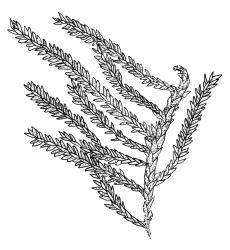Elements in the following description are taken from Noguchi (1987–1994).
Plants small, filiform, on tree trunks or occasionally on rock. Primary stems inconspicuous, creeping, and nearly leafless. Secondary stems irregularly or sub-pinnately branched, lacking a central strand. Stem leaves appressed and imbricate when dry, erect- or widely spreading when moist, ovate-lanceolate, rounded at apex, fragile or not, crenate at margins, costate. Branch leaves either lingulate or lanceolate from an ovate base or ovate-lanceolate, obtuse, acute, or rarely piliferous at apex; margins crenulate due to inflated cells, occasionally dentate above; mid laminal cells quadrate- or rounded-hexagonal, thin-walled, sometimes obscure in surface view, with several or rarely one papillae over the lumen; juxtacostal cells smooth, more elongate, and thicker-walled; alar cells not differentiated. Costa variable in length but mostly to mid leaf or beyond, often protruding weakly on abaxial surface, mostly smooth, pellucid. Paraphyllia lacking.
Dioicous. Perichaetia with numerous, filiform, and conspicuous paraphyses; inner perichaetial leaves oblong-ovate and narrowly attenuate. Perigonia gemmiform, scattered on stems and branches. Setae elongate and smooth; capsules erect, oblong to subglobose; mouth transverse and small; stomata lacking; annulus of large cells; operculum rostrate. Peristome double; exostome teeth linear-lanceolate, often split along median line, coarsely papillose above, pellucid; endostome reduced, lacking segments and cilia. Calyptra cucullate, lobed, and sparsely hairy.
Haplohymenium is a modest-sized genus best developed in eastern Asia. A treatment of the five species occurring in Japan (Noguchi 1987–1994) is helpful, and draws on Noguchi’s earlier generic revision (not accessed while writing this treatment). Haplohymenium has been variously placed in the Leskeaceae, Thuidiaceae, and the Anomodontaceae. Although Haplohymenium has sometimes been included within Anomodon (Granzow-de la Cerda 1997), I have utilised here a more traditional circumscription of the genera, in agreement with Noguchi (1987–1994) and Crum & Buck (1994). According to the latter Haplohymenium can be distinguished from Anomodon by its having "more slender gametophytes, oblong-ovoid capsules, exostome teeth with large papillae or irregular thickenings, endostome without segments or cilia, and hairy calyptrae". The genus is likewise retained by Goffinet et al. (2009).
| Category | Number |
|---|---|
| Indigenous (Non-endemic) | 1 |
| Total | 1 |




